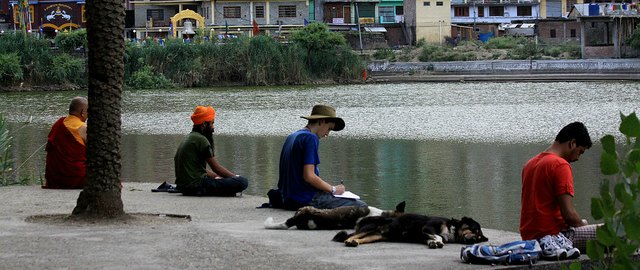
Rewalsar Lake
Legend has it that Padmasambhava, the sage who brought Buddhism to India, 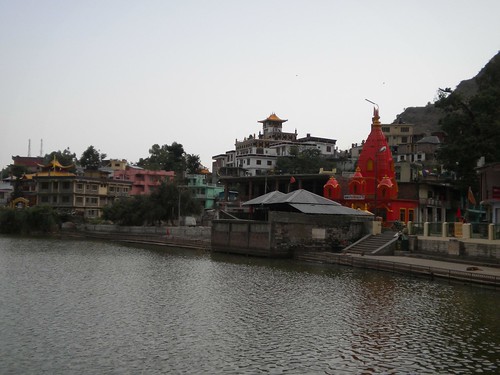 was condemned to die in a fire here by the king of Mandi. However, when the fire eventually died out, the sage was seen sitting calmly on a lotus, which bloomed in the middle of a large lake – Rewalsar! HP tourism promotes the lake as the confluence of religions and quite rightly so. Along with grand Tibetan and Bhutanese Buddhist monasteries are a simple Gurudwara and a couple of, even simpler, Hindu temples, all of which attract thousands of devotees from around the country. It’s probably the most unique, religious place, Madhu and I’ve been to!
was condemned to die in a fire here by the king of Mandi. However, when the fire eventually died out, the sage was seen sitting calmly on a lotus, which bloomed in the middle of a large lake – Rewalsar! HP tourism promotes the lake as the confluence of religions and quite rightly so. Along with grand Tibetan and Bhutanese Buddhist monasteries are a simple Gurudwara and a couple of, even simpler, Hindu temples, all of which attract thousands of devotees from around the country. It’s probably the most unique, religious place, Madhu and I’ve been to!
Yesterday morning we took a cab from Shoja to Rewalsar, covering about 120kms in 3hrs. 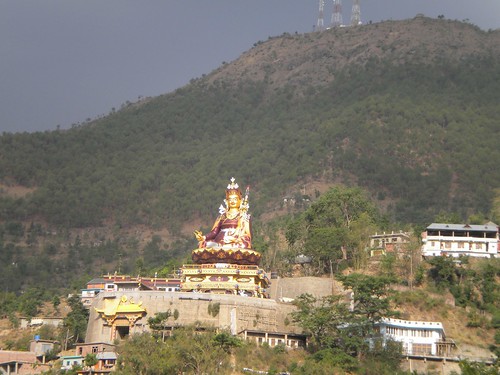 The route followed the river Beas west to Mandi where a Hydro Electric project stemmed its flow, making the water look green and almost stagnant. Strangely the roads until here and beyond were wide and very nicely maintained and for the first time in HP, we travelled at speeds above 20kms an hour! From Mandi, which looked like mini-Shimla with narrow, congested streets, Rewalsar Lake is about 25kms southwest, winding up a hill to a height of 4100ft. Just as we neared the village, a huge figure of Padmasambhava seated with a Trishul in his left hand, could be made out in the distance; he could easily be mistaken for Lord Shiva! Madhu had called Hotel Lotus Lake in advance and we were able to check into one of their spacious rooms almost immediately. By this time the afternoon heat was even worse than it had been at Shoja, so we stepped out for a quick lunch of Momos and Chowmein, before hurrying back to the comforts of our room for a siesta.
The route followed the river Beas west to Mandi where a Hydro Electric project stemmed its flow, making the water look green and almost stagnant. Strangely the roads until here and beyond were wide and very nicely maintained and for the first time in HP, we travelled at speeds above 20kms an hour! From Mandi, which looked like mini-Shimla with narrow, congested streets, Rewalsar Lake is about 25kms southwest, winding up a hill to a height of 4100ft. Just as we neared the village, a huge figure of Padmasambhava seated with a Trishul in his left hand, could be made out in the distance; he could easily be mistaken for Lord Shiva! Madhu had called Hotel Lotus Lake in advance and we were able to check into one of their spacious rooms almost immediately. By this time the afternoon heat was even worse than it had been at Shoja, so we stepped out for a quick lunch of Momos and Chowmein, before hurrying back to the comforts of our room for a siesta.
The heat dulled us both into a deep sleep and we didn’t venture back out until 6:30pm. Our first stop was the Nyingmapa Gompa, which is one of the oldest Tibetan Buddhist temples around the lake. It was conveniently located just a few  meters away from our hotel. To the left of the main entrance was a reception area for those who wanted to stay in the dorms within the temple compound; seemed to be quite popular amongst visitors! Right next to the reception area was the 2-storied temple fronted by a nice, open courtyard. We entered the structure and made our first-ever parikrama of a Buddhist temple, around its inner sanctum, turning the numerous prayer wheels that encircled it. Unfortunately, the inner sanctum was locked at that time. We enquired about this to a man, who was probably one of the staff at the monastery. He pointed to a lady monk who was lighting some lamps in the courtyard, saying that she would open the inner sanctum for us right then, if we so desired. He then, helpfully, went across to her, made the request on our behalf and disappeared. On her part, the lady monk, peeled herself away from her task and opened the inner sanctum immediately; we were absolutely thrilled. By then it was starting to get dark outside and when the lady monk tried the lights within the prayer hall she realized that there was no electricity. Without lights we could barely see anything. She said, in broken, halting Hindi that if we returned the following morning at 7am we could watch the Lamas (gurus) perform the morning rituals in the temple. We thanked her for her help and promised to be back in the morning.
meters away from our hotel. To the left of the main entrance was a reception area for those who wanted to stay in the dorms within the temple compound; seemed to be quite popular amongst visitors! Right next to the reception area was the 2-storied temple fronted by a nice, open courtyard. We entered the structure and made our first-ever parikrama of a Buddhist temple, around its inner sanctum, turning the numerous prayer wheels that encircled it. Unfortunately, the inner sanctum was locked at that time. We enquired about this to a man, who was probably one of the staff at the monastery. He pointed to a lady monk who was lighting some lamps in the courtyard, saying that she would open the inner sanctum for us right then, if we so desired. He then, helpfully, went across to her, made the request on our behalf and disappeared. On her part, the lady monk, peeled herself away from her task and opened the inner sanctum immediately; we were absolutely thrilled. By then it was starting to get dark outside and when the lady monk tried the lights within the prayer hall she realized that there was no electricity. Without lights we could barely see anything. She said, in broken, halting Hindi that if we returned the following morning at 7am we could watch the Lamas (gurus) perform the morning rituals in the temple. We thanked her for her help and promised to be back in the morning.
With nothing else to do but wander around, Madhu and I followed the motorable road that winds around the lake, before getting back to the market area for an early dinner; a short day of sightseeing!
Today morning, we woke up early and were at the Nyingmapa Gompa at 7am sharp. 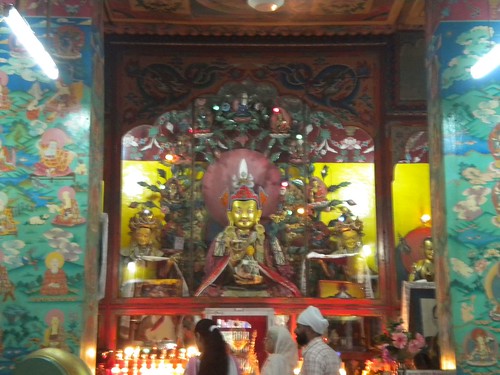 And just like the lady monk had said the previous evening, the temple was open with many Buddhist priests seated in a row on either side of the entrance. A low table in front of them seemed to hold their prayer items while they chanted methodically. Madhu and I almost felt like we were intruding as we stepped into the sacred hall; the interiors were beautiful! Since this was the first time we were stepping into a Buddhist temple, we were quite overawed with the colorful murals that covered the inner walls. The large idol of Padmasambhava, adorned with silk and jewelry, against the far wall of the temple was gorgeous and eye-catching. Devotees offered little baskets of fruits, biscuits and money and reverently touched the base of the idol with their foreheads. Madhu and I were mesmerized by all of this but didn’t stay long; we paid our respects and left. I would have loved to explore the innards of the temple more carefully, learning and understanding what each mural and prayer item in the temple stood for, but there just didn’t seem anybody that we could approach or talk to. Everybody seemed to be completely focused in their own spiritual world and we just didn’t have the heart to disturb them.
And just like the lady monk had said the previous evening, the temple was open with many Buddhist priests seated in a row on either side of the entrance. A low table in front of them seemed to hold their prayer items while they chanted methodically. Madhu and I almost felt like we were intruding as we stepped into the sacred hall; the interiors were beautiful! Since this was the first time we were stepping into a Buddhist temple, we were quite overawed with the colorful murals that covered the inner walls. The large idol of Padmasambhava, adorned with silk and jewelry, against the far wall of the temple was gorgeous and eye-catching. Devotees offered little baskets of fruits, biscuits and money and reverently touched the base of the idol with their foreheads. Madhu and I were mesmerized by all of this but didn’t stay long; we paid our respects and left. I would have loved to explore the innards of the temple more carefully, learning and understanding what each mural and prayer item in the temple stood for, but there just didn’t seem anybody that we could approach or talk to. Everybody seemed to be completely focused in their own spiritual world and we just didn’t have the heart to disturb them.
Our next stop was the Drikung Kagyu Gompa, for which we walked back towards our hotel 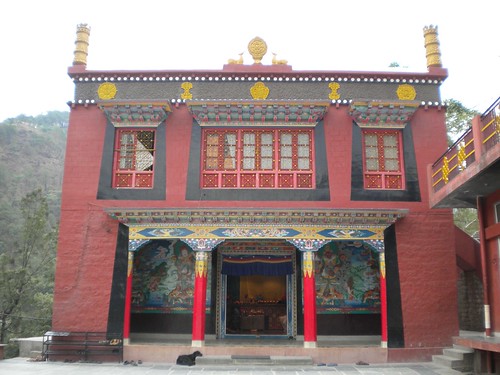 and then beyond it until we got to a large, red entrance that looked like it would lead us to a Buddhist temple. However, when we entered it and walked up a slope, we only saw a squat building to our right with no temple in sight. So we went back down to the entrance and enquired with a person at a tea stall. At first he couldn’t understand which Buddhist temple we were trying to get to as the name Drikung Kagyu was alien to him. He finally shrugged and said that he only knows of a DK Gompa, which is up the same slope that we had been to a few minutes ago! Realizing that the temple we were looking for was locally known as DK Gompa, we thanked him and went back up the slope to find a small alley that led to the right and then up a few steps. Here the lovely, one-storied, deep red temple stood majestically at the end of a large courtyard. We walked over to its entrance, removed our footwear and peeked into the interiors. The pillared porch had beautiful, colorful murals. Surprisingly, its innards weren’t as grand as the outside structure but austere and simple. Here too Lamas prayed sitting in two rows flanking the main altar at the far end. Two young monks were serving them with what looked like tea and a round piece of bread like a Nan; probably breakfast for the day.
and then beyond it until we got to a large, red entrance that looked like it would lead us to a Buddhist temple. However, when we entered it and walked up a slope, we only saw a squat building to our right with no temple in sight. So we went back down to the entrance and enquired with a person at a tea stall. At first he couldn’t understand which Buddhist temple we were trying to get to as the name Drikung Kagyu was alien to him. He finally shrugged and said that he only knows of a DK Gompa, which is up the same slope that we had been to a few minutes ago! Realizing that the temple we were looking for was locally known as DK Gompa, we thanked him and went back up the slope to find a small alley that led to the right and then up a few steps. Here the lovely, one-storied, deep red temple stood majestically at the end of a large courtyard. We walked over to its entrance, removed our footwear and peeked into the interiors. The pillared porch had beautiful, colorful murals. Surprisingly, its innards weren’t as grand as the outside structure but austere and simple. Here too Lamas prayed sitting in two rows flanking the main altar at the far end. Two young monks were serving them with what looked like tea and a round piece of bread like a Nan; probably breakfast for the day.
Just a few meters beyond the DK Gompa, along the road that wraps around the lake, is the Gurudwara,  which was built here in honor of Guru Gobind Singh in the 1930s. Steep steps as well as a motorable road lead up to it from the lake. The single-storied structure is unadorned and quite simple. Luckily, for us the temple was open, so we covered our heads, walked in, and paid our respects. The resident priest offered us some Prasad of Sheera (Semolina cooked with sugar in ghee), which was unbelievably yummy. He later joined us outside in the courtyard and chatted quite pleasantly. He was interested in buying a SLR camera for a family member and enquired with Madhu about what to buy and prices. He then asked us to stop by the adjoining hall where Langar is served everyday for some chai. The hall was a large one supported by pillars with seating mats lining the floor. Near the windows, left of the entrance, were wash basins to rinse the plates and glasses after meals. To the right was a large platform where all the rinsed plates, glasses and bowls of all shapes and sizes glistened. We sat on one of the mats and quietly drank the sweet chai as we watched volunteers go about their daily chores; it was a nice experience!
which was built here in honor of Guru Gobind Singh in the 1930s. Steep steps as well as a motorable road lead up to it from the lake. The single-storied structure is unadorned and quite simple. Luckily, for us the temple was open, so we covered our heads, walked in, and paid our respects. The resident priest offered us some Prasad of Sheera (Semolina cooked with sugar in ghee), which was unbelievably yummy. He later joined us outside in the courtyard and chatted quite pleasantly. He was interested in buying a SLR camera for a family member and enquired with Madhu about what to buy and prices. He then asked us to stop by the adjoining hall where Langar is served everyday for some chai. The hall was a large one supported by pillars with seating mats lining the floor. Near the windows, left of the entrance, were wash basins to rinse the plates and glasses after meals. To the right was a large platform where all the rinsed plates, glasses and bowls of all shapes and sizes glistened. We sat on one of the mats and quietly drank the sweet chai as we watched volunteers go about their daily chores; it was a nice experience!
The chai made us realize that we hadn’t had breakfast yet, so we filled up on parathas and omelets at a cafe called Kora Community Cafe, which seemed to be quite popular with the foreigners. It’s a small cafe with 2 bench seats on the verandah and about 4 tables inside. They advertised to be providers of authentic ‘Indian Coffee’ and it seemed to be what most of their customers were ordering as well. I liked their Ginger Lemon Honey Tea – it was yummy! The outside seating is a great place for people-watching in the evenings!
Apart from Tibetan Buddhist temples, Rewalsar also has a lovely Buddhist temple run by Bhutanese. 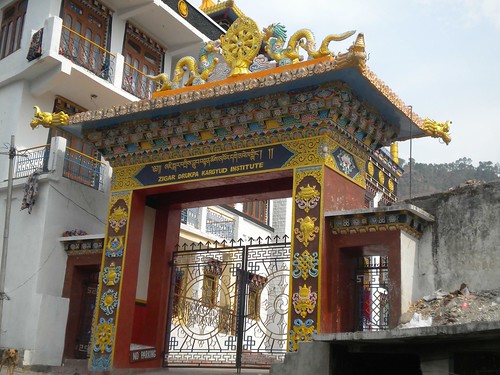 Called the Zigar Drukpa Kargyu Institute, it houses a study and meditation center for Buddhists students. It had the prettiest exterior with dark wood windows on a white-washed background. As we entered through its gated entrance, we heard chanting and cymbals, which sounded quite exotic! Inside the large idol of a seated Buddha was magnificent as it sat benignly on a lovely golden throne. Exquisite murals were painted on the other walls. Silk paintings hung from the ceiling and framed the main idol beautifully. Pictures of the current Dalai Lama and 2 other monks whom I didn’t recognize were framed and placed just before the altar. We stood around listening to the chanting and bells for quite a while!
Called the Zigar Drukpa Kargyu Institute, it houses a study and meditation center for Buddhists students. It had the prettiest exterior with dark wood windows on a white-washed background. As we entered through its gated entrance, we heard chanting and cymbals, which sounded quite exotic! Inside the large idol of a seated Buddha was magnificent as it sat benignly on a lovely golden throne. Exquisite murals were painted on the other walls. Silk paintings hung from the ceiling and framed the main idol beautifully. Pictures of the current Dalai Lama and 2 other monks whom I didn’t recognize were framed and placed just before the altar. We stood around listening to the chanting and bells for quite a while!
A new temple, Zigar Choekhorling, is currently under construction atop a small hillock and 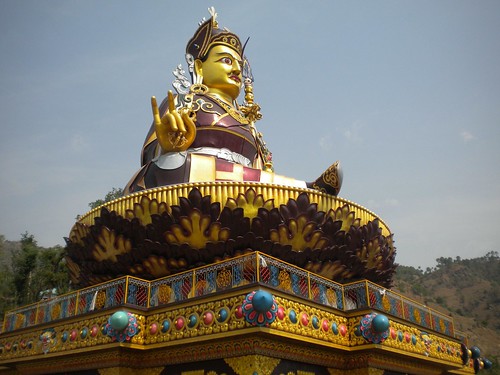 here is where the 12m high statue of Padmasambhava that we had seen on our way into the village, is placed. The exteriors of the temple, including its entry gateway and the statue atop it, have been completed already but the interiors are just about getting started. When we walked in, there were scaffoldings and painting materials everywhere. 3 large idols of Buddha, made of wood (looked almost like sandalwood) were complete but needed to be painted upon. The ceilings were complete with absolutely beautiful paintings. Men sat on wooden platforms built against the walls and were either sketching or filling in the sketches with paint; it was fascinating to watch. The entire surface of the walls was going to be painted on with intricate designs and stories; it looked like a lot of work; but rewarding I’m sure!
here is where the 12m high statue of Padmasambhava that we had seen on our way into the village, is placed. The exteriors of the temple, including its entry gateway and the statue atop it, have been completed already but the interiors are just about getting started. When we walked in, there were scaffoldings and painting materials everywhere. 3 large idols of Buddha, made of wood (looked almost like sandalwood) were complete but needed to be painted upon. The ceilings were complete with absolutely beautiful paintings. Men sat on wooden platforms built against the walls and were either sketching or filling in the sketches with paint; it was fascinating to watch. The entire surface of the walls was going to be painted on with intricate designs and stories; it looked like a lot of work; but rewarding I’m sure!
By now it was almost 11am and the morning sun was quite harsh. So we hurried back to our hotel and stayed indoors for the rest of the afternoon, preferring to eat lunch at our hotel’s restaurant, which turned out to be quite good. In the evening, we ventured out again and this time, since we were done with the temples of the area, decided to give the lake a closer look. On the way we browsed the many stores that line the streets. They sell mainly junk jewelry, artifacts and hand-woven shawls. The junk jewelry was interesting but I didn’t buy any; they didn’t look to be of very good quality. As we walked on we neared the edge of the lake where the Hindu temples were located. They were garishly painted and didn’t seem to be attracting a lot of people. In fact, so far we had seen mainly Buddhist and Sikh devotees in Rewalsar.
Old women sat near the edge of the lake selling small bags of puffed rice that can be fed to the fish 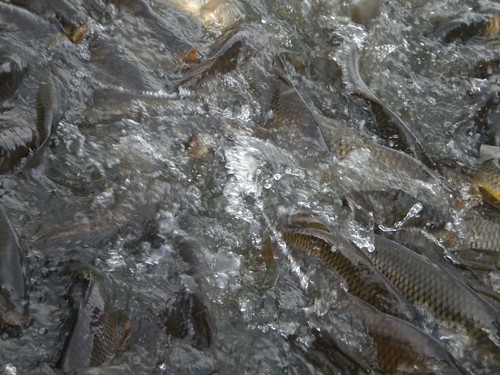 in the lake. We bought a bag worth Rs.5 from them. A few steps down from the road took us right by the water where we could see quite a few fish calmly swimming near the surface. But the minute I threw in a handful of puffed rice into the water, there was a furious splash of water and hundreds of fish surfaced trying to get a bite. It was almost a scary sight! They battled furiously for the little tidbits. It was quite clear that the fish were used to being fed and preferred swimming near the shore where the people were likely to throw stuff at them. Since fishing is not allowed in these waters, their numbers have swelled considerably. As we walked around the lake, I was quite sure that there were hundreds of them out there!
in the lake. We bought a bag worth Rs.5 from them. A few steps down from the road took us right by the water where we could see quite a few fish calmly swimming near the surface. But the minute I threw in a handful of puffed rice into the water, there was a furious splash of water and hundreds of fish surfaced trying to get a bite. It was almost a scary sight! They battled furiously for the little tidbits. It was quite clear that the fish were used to being fed and preferred swimming near the shore where the people were likely to throw stuff at them. Since fishing is not allowed in these waters, their numbers have swelled considerably. As we walked around the lake, I was quite sure that there were hundreds of them out there!
Yesterday, we had walked on the main, motorable road that runs around the lake. 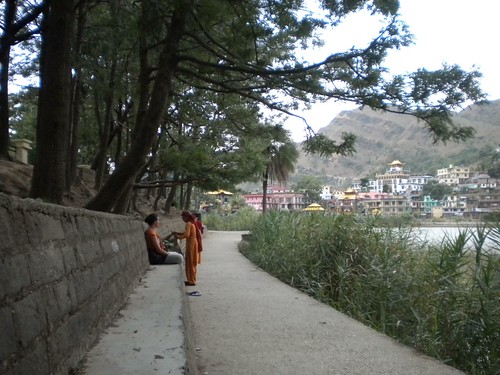 Today we walked on the paved pathway, which runs around the edge of the water for about two-thirds of the way. A thick ring of grassy area separates the main road from this pathway, providing the people and visitors of Rewalsar a nice place to picnic in. Further along, a cemented platform, shaded by trees, has been built by the pathway where it is quite pleasant to sit and gape at the stream of humanity passing by. As we sat here, enjoying the lovely evening, we realized that we had quite enjoyed Rewalsar. It has a devout, serene air, which is hard to find elsewhere. Buddhists can be seen walking around, doing Parikrama of the lake with prayer wheels in hand and chanting softly. Some others can be seen finding a quiet corner to meditate or just plain lounge. We loved this atmosphere and could understand why it was so popular with devotees!
Today we walked on the paved pathway, which runs around the edge of the water for about two-thirds of the way. A thick ring of grassy area separates the main road from this pathway, providing the people and visitors of Rewalsar a nice place to picnic in. Further along, a cemented platform, shaded by trees, has been built by the pathway where it is quite pleasant to sit and gape at the stream of humanity passing by. As we sat here, enjoying the lovely evening, we realized that we had quite enjoyed Rewalsar. It has a devout, serene air, which is hard to find elsewhere. Buddhists can be seen walking around, doing Parikrama of the lake with prayer wheels in hand and chanting softly. Some others can be seen finding a quiet corner to meditate or just plain lounge. We loved this atmosphere and could understand why it was so popular with devotees!
Later in the evening, our last one here, we went back to Kora Community Cafe found a seat on the verandah and did some more people-watching – it’s the best thing to do in Rewalsar.


Hi guys, your buddhist circuit seems to have started off well at Rewalsar. I have never been there. Sounds like a different kind of place in the Himachal context. Keep posting.Om mani padme hum.
Hey Pavel,
Good to hear from you. How are you doing?
We are now in Dalhousie, will push off to Srinagar in a few.
Cheers!
Good one. Waiting for kashmir photos.